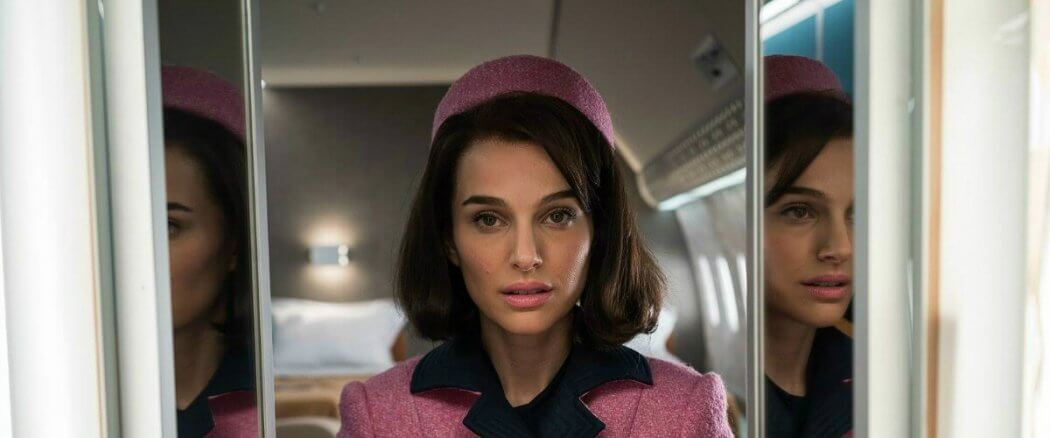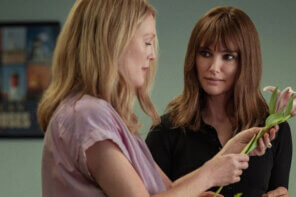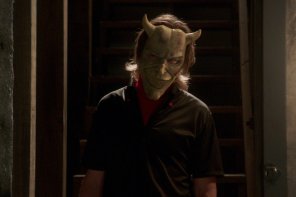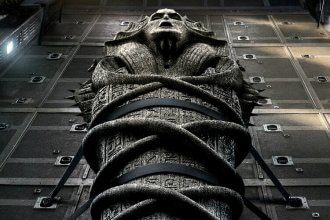We all have days in our lives that we will remember for as long as we take breath and God grants our mental competence. Many of those are personal… our marriage, the birth of our children, funerals of family members and tragedies that some of us have endured. And most of us have a few public moments where the world or some smaller part of it remembers an event either celebratory or catastrophic. My two foremost tragic memories are, of course, Tuesday 9/11/2001 and the assassination of President Kennedy on Friday 11/23/1963. That last date will be forever burned into my junior-in-high-school memory. Seeing Jackie brings those memories to the forefront once again, but from a visualized perspective never before known.
Basis of the Film — Fact or Supposition?
Jackie portrays the four days encompassing President Kennedy’s assassination on Friday, November 23, 1963 until his funeral on Monday, November 26 through the eyes of the First Lady. It is a four day “biopic” which, if a true depiction, reveals a great deal about its namesake. Told through an interview with an unnamed journalist nicely played by Billy Crudup (so incredible in Almost Famous), it takes place at a cold and sterile Hyannis Port mansion sometime in the first few weeks after President Kennedy’s death. The journalist is never named but in truth the interview is based on a one-on-one sit down Mrs. Kennedy granted to Theodore H. White. His notes from that extensive interview (barely legible and written — unlike the movie depiction — on a yellow legal pad) have now, after Jacqueline’s death, been released. However for reasons unclear other than his affection towards Jackie, White only published a two page “Epilogue” in Life magazine immediately following the interview. As the film repeatedly returns to the interview, we see one flashback after another of Jackie’s tenure as the first lady, and especially the trauma of those four November days.
Jacqueline Kennedy the Historical Figure
To understand this biopic, one must know that in the early 1960s there was no woman in America who was more admired than first lady Jacqueline Lee Bouvier Kennedy. Beautiful, sophisticated, and elegant, she epitomized in that era what most women wanted to be and most men wanted to marry. Born to parents that divorced early in her childhood and reared in a twenty-eight room mansion by her mother and her very wealthy step-father, Jackie was an intelligent but shy and private person. She was christened and confirmed in the Catholic church of her biologic father but always felt somewhat ostracized in her step-father’s WASPish society. In her teens she retreated into literature, arts and fashion. She became incredibly accomplished, speaking a number of languages and achieving several academic honors. America and the White House had never seen any First Lady like her.
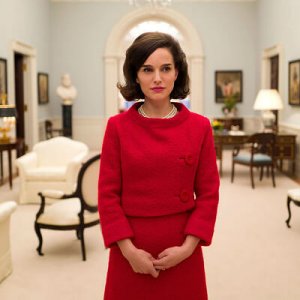 When she entered the White House in January 1961, Jackie was appalled at its bland outfitting with so few artifacts rooted in American history. Indeed, much of the furniture in the White House had been bought, during the Truman-era renovation of the White House, from a department store. Jackie set about the “hard work” (Lady Bird Johnson’s description of her efforts), and absorbed the political blows, to perform a huge overhaul of the “people’s house.” Her goal was to fill the White House with the most notable American furniture, sculptures, art and décor possible — to make it “the most perfect house.” Again in her words from the film, “Objects and artifacts last longer than people.” She quickly ran out of funds for the overhaul and raised private donations for the remainder. Her husband’s foes in congress were outraged at her “extravagance” and even during the four days of mourning portrayed here, there are numerous references to the opposition and criticism she had endured.
When she entered the White House in January 1961, Jackie was appalled at its bland outfitting with so few artifacts rooted in American history. Indeed, much of the furniture in the White House had been bought, during the Truman-era renovation of the White House, from a department store. Jackie set about the “hard work” (Lady Bird Johnson’s description of her efforts), and absorbed the political blows, to perform a huge overhaul of the “people’s house.” Her goal was to fill the White House with the most notable American furniture, sculptures, art and décor possible — to make it “the most perfect house.” Again in her words from the film, “Objects and artifacts last longer than people.” She quickly ran out of funds for the overhaul and raised private donations for the remainder. Her husband’s foes in congress were outraged at her “extravagance” and even during the four days of mourning portrayed here, there are numerous references to the opposition and criticism she had endured.
Jackie’s renovation efforts finally reached a stage of completion where she agreed to a White House tour which was broadcast in black and white by two major television networks (NBC and CBS) on February 14, 1962 and by ABC four days later. The broadcast was the first ever “First Lady Tour” of the White House and is considered the first prime-time documentary meant to appeal to women. Jackie repeatedly recreates aspects of the tour in black and white flashbacks, but the film also contains numerous behind-the-scene clips (filmed in color) which show how anxious and insecure Jackie was while hosting the event. While to our eyes Jackie may seem stiff and formal during the TV special, the show was a huge success. It helped cement her place in American First Lady history as the most knowledgeable, poised, and graceful presidential wife the nation had ever known.
The Kennedy First Family
Again to understand this film, one must know that Jacqueline was trying to provide the president with multiple children, as befitted an Irish-Catholic family (and in no small competition to Bobby Kennedy’s wife Ethel, who by this time had already produced 8 living children). Her first pregnancy in 1956 ended in the miscarriage of a daughter, informally named Arabella (but her gravestone marker says only “Daughter”). She had another early miscarriage in 1957 and finally delivered Caroline in late 1957. Once again pregnant during her husband’s presidential campaign, she delivered John Jr. later in the month of JFK’s November 1960 presidential election. Finally, her pregnancy while First Lady resulted in the premature birth of a son Patrick who died at two days of age due to hyaline membrane disease (prematurity of the lungs). This occurred in August of 1963, only three months before the period of this film — a period during which Jackie considered herself to still be in mourning for Patrick’s death. Five pregnancies in ten years, only two of which survived — and then the death of her husband.
That Day
In the movie’s first flashback, we see the all too familiar pink Chanel suit as Jackie adjusts her matching pillbox hat in a small wall mirror on Air Force One. It is that fateful day in Dallas… Friday, November 23, 1963. We see Jackie from the back as she adjusts her hat on her coiffed hair saying to herself “People like to believe in fairy tales.” As she turns and comes to the hatch of the Boeing 707 and the steps descend to the tarmac, the president asks her “You ready?” to which Jackie replies “Of course.” A few seconds later she adds, sarcastically, “I love crowds.”
 And down the stairs they come to the officials at the bottom, the placards, and the cheers of the mob. This scene, where Jackie struggles to keep her smile on her face while seeming to recoil from the confusion and press of the crowd, has an ominous tone which foretells the horror to come. We follow Jackie in interrupted flashbacks, first watching her tell of some aspect of an event and then seeing it happen, at least as Jackie remembered it. Sometimes we see portrayed the events as she wanted people to know of it, and then later we might see the scene again with what she truly experienced.
And down the stairs they come to the officials at the bottom, the placards, and the cheers of the mob. This scene, where Jackie struggles to keep her smile on her face while seeming to recoil from the confusion and press of the crowd, has an ominous tone which foretells the horror to come. We follow Jackie in interrupted flashbacks, first watching her tell of some aspect of an event and then seeing it happen, at least as Jackie remembered it. Sometimes we see portrayed the events as she wanted people to know of it, and then later we might see the scene again with what she truly experienced.
For the duration of the film, the flashbacks hop back and forth, but generally the narrative continues moving forward to the state funeral held on November 26. She wanted the funeral to be like President Lincoln’s realizing he was the only assassinated president (as opposed to Presidents Garfield or McKinley) that people held in awe and whose accomplishments they remembered. And then we are back at the interview, with the reporter carefully probing her memories while Jackie chain smokes.
One Woman, Many Faces
We see so many “Jackies.” Cynical… “I never wanted fame… I just married a Kennedy.” Or angry… “There were ‘Wanted’ posters with Jack’s face on them. Let them see what they’ve done.” Or wise… “A first lady must always be ready to pack her suitcase — It’s inevitable.” Or unreasonable (when discussing the funeral), “There should be more horses, more soldiers, more crying, more cameras…” Or iron-willed and acerbic (when discussing the hesitance of some state leaders to march with her at the state funeral), “Inform them that I will walk with Jack tomorrow… alone if necessary. And tell (French President) General de Gaulle that if he wishes to ride in an armored car, or in a tank for that matter, I won’t blame him. And — and I’m sure the tens of millions of people watching won’t either.” Or cunning, as when the reporter says after she is too honest with him, “I’m guessing you won’t allow me to write any of that?” and Jackie answers, ignoring what she had just said, “No, because I never said that.“ But most of all we see a grieving Jackie… as when she hopes someone will shoot her when she walks with the President’s casket, “I pray to die. Oh God, let me be with my husband.” But for what is she grieving? She murmurs to herself, “I lost track somewhere. What was real and what was performance.”
The Faith of Jackie
During the interview, when asked how her faith has served her, Jackie replies that she will keep that between herself and her priest. Yet there are numerous scenes of a conversation between a priest (well played by John Hurt) which take place, oddly enough, in a turnabout outside her limousine and surrounded by secret service agents. When the (unnamed) priest answers her plea as to “Where is God?” with the bland “God is everywhere,” Jackie icily responds “Was he in the bullet that killed Jack?” The priest brings up Christ healing the man born blind by putting mud on his eyes and having him bathe in the Pool of Siloam (John 9). Hurt’s character ends by saying “You have been chosen so works of God may be revealed in you.” From that theologically hopeful story the priest later, less helpfully, says “There comes a time… you realize there are no answers. And you can either kill yourself or stop looking for answers. And then you wake up the next morning and make your coffee…” I prefer 1 Corinthians 13:12.
A Tour de Force
There is little I can say about Natalie Portman’s portrayal of Jacqueline that has not already been said. She becomes Jackie. Her whispery delivery may be over the top but it is evocative of the First Lady as I and many remember her. Her recreated black and white tour of the White House is just as it was. And Portman’s face portrays many emotions on the surface — and many which are not. She delivers a complicated performance, one which produces empathy yet makes Jackie prickly and difficult to fully embrace. Her stiff posture and, most of the time, stiff upper lip make one realize Jackie’s toughness and the fact she guarded herself from the world, especially after what they did to Jack. While the president’s affairs and dalliances are never directly addressed, her behavior portrays a woman who is determined to maintain her pride and the ideal of what Jack’s administration could have been, the truth be damned. Many are saying Portman will add to the Oscar she won for Black Swan and I would fully endorse that. The only other leading actress I have seen this year rivaling Portman’s acting is Emily Blunt in Girl on the Train, a comparatively inferior film.
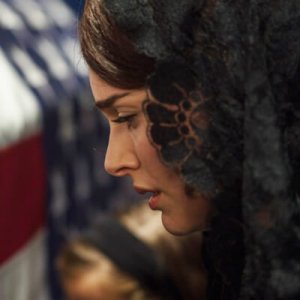 How unlikely that Chilean Director Pablo Larrain is the person to bring such understanding to an American heroine. Not well known in this country, he does have excellent films in his directorial resume, mainly 2012’s engrossing political drama No and last year’s religious and human character study The Club. He seems to have a mastery of this American mystery, this woman. His tight focus on Portman’s face and, especially, her eyes make this film very personal. And there is wonderful cinematography (look for the reflection of the sober crowds moving by Jackie’s somber face peering out her limo window, or the breathtaking view from the peak of the rotunda as JFK’s casket is wheeled into place).
How unlikely that Chilean Director Pablo Larrain is the person to bring such understanding to an American heroine. Not well known in this country, he does have excellent films in his directorial resume, mainly 2012’s engrossing political drama No and last year’s religious and human character study The Club. He seems to have a mastery of this American mystery, this woman. His tight focus on Portman’s face and, especially, her eyes make this film very personal. And there is wonderful cinematography (look for the reflection of the sober crowds moving by Jackie’s somber face peering out her limo window, or the breathtaking view from the peak of the rotunda as JFK’s casket is wheeled into place).
The music by Mica Levi is unique — a wail of grief in the minor key opens the movie and is a recurring theme throughout the score (it has been made available here to stream free-of-charge in its entirety but listen, especially, to the striking “Intro”). There are other actors who deserve kudos, especially Peter Sarsgaard (Jarhead) as Bobby Kennedy, the only male Jackie trusted, as well as Greta Gerwig (Frances Ha, Maggie’s Plan) playing Jackie’s long-time friend and social secretary. But the movie is Portman’s. Her lonely wandering through the White House on the night after the assassination, dressing in her sumptuous state gowns while uninhibitedly smoking, drinking and staring at the furniture and artwork she had placed there — her face frozen — is hypnotic. It reminds one of the elegant but unreal atmosphere of the “Space Hotel” in 2001: A Space Odyssey.
A Fairy Tale Lost
Jack Kennedy loved the fantasy musical Camelot based on the Arthurian legend of a castle surrounded by an atmosphere of idyllic happiness. According to Jackie his favorite musical selection was the title song but not the merry opening number version. Rather it was the more plaintive “Finale Ultimo” which closes the show, the lyrics of which Jackie keeps repeated to herself while enduring those four days:
Don’t let it be forgot
That once there was a spot
For one brief shining moment that was
Known as Camelot.
In the film’s final scene we see another flashback of JFK and Jackie dancing at a White House function. She is wearing another of her classic gowns and has a brilliant smile on her face as she gazes into JFK’s face. She is a figure of beauty and grace, and they are a lovely couple. Then she lowers her head onto his shoulder and almost immediately loses the smile. She stares at the camera with a troubled look, one that wishes things really were as they seemed — that Camelot was real and not a performance.

